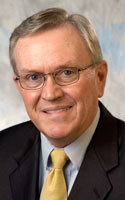  |
| HOME | THIS ISSUE | CALENDAR | GRANTS | BACK ISSUES | < BACK | NEXT > |
From the President- August 28, 2006 |
||||
Highly ranked again in the recent U.S. News ratings, the University is preparing this year for institutional reaccreditation, as well as external evaluation of our research and athletic operations. Welcome back! And, to the new faculty and staff members joining us this fall, welcome to UConn. I have had the opportunity to meet many of you over the past several days, and I know we made the right choice in asking you to join us. I'm confident that you'll soon know you made the right choice as well. This past Friday I delivered a similar welcome to approximately 3,200 freshmen and 700 transfer students starting out at Storrs. The new class continues the trend that's now of several years' duration: the students are academically stronger, more diverse, more ambitious, and even more eager to be here than their predecessors. An article on page 1 of this week's Advance reports some of the quantitative measures. As for the qualitative aspects - creativity, enthusiasm, sense of engagement in the University and the world outside - we can judge those for ourselves. I'm sure we will continue to like what we see. This semester our 125th year commemoration comes to a close. It has been good to reflect on an inspiring heritage; like every large, vital organization, UConn stands to benefit from periodic introspection. As we approach our 126th anniversary on April 21, 2007, we can say with a high degree of confidence that the University continues to build on a solid foundation and to move in the right direction. In the coming year, a major focus will be on external assessment. We got a taste of that this past week, as U.S. News & World Report came out with its annual ratings and UConn moved up a slot, to number 27 among public universities. Others in that neighborhood include Rutgers, the University of Georgia, Purdue, the University of Delaware, the University of Minnesota, and Michigan State - good company to be in. It's customary to say that we don't take these ratings too seriously, but the fact is that prospective students and their parents do look at them very closely, and it's good to be rated by this one source among the nation's top publics and, indisputably, the top public in New England. More significant evaluations will come later in the year. Several dozen faculty and staff have been hard at work since last fall preparing the self-study for our 10-year review by the New England Association of Schools and Colleges (NEASC), UConn's regional accrediting body. The self-study will be followed in January 2007 by the visit of an external team, to be led by Chancellor Mark Nordenberg of the University of Pittsburgh, and later in the year by a determination of our accreditation status by the NEASC Commission on Institutions of Higher Education. This year we are also beginning formal preparation for the National Research Council's assessment of graduate programs in the sciences, humanities, and engineering, leading to formal review next year. And, as always, individual programs go through their own accreditation process, several of which are ongoing in any given year. UConn's policy is that every program subject to this credential must attain and retain it, and this goal has been met. Other activities are evaluated externally as well. UConn's athletic program will undergo an NCAA assessment this year and, as was the case when we went through the NCAA accreditation in 1997, many faculty and staff will be asked to assist in that effort. The process of external review and reaccreditation is labor-intensive. But it is also invaluable to institutions, including UConn, who use it as an opportunity to focus on strengths that need to be maintained and challenges that need to be met. It is also healthy for higher education as a whole, since it blends institutional self-governance with external accountability. It has served the nation's colleges and universities well. I mention this not just because the evaluations will be important to us this year but because there have been recent calls to alter the higher education assessment process drastically. A draft report issued by the U.S. Department of Education's Commission on the Future of Higher Education calls for "a transformation of accreditation," and suggests standardized testing of college students, analogous to the testing of K-12 students mandated by the "No Child Left Behind" program adopted early in the Bush Administration. While the current system may be open to improvement, I hope policy-makers think long and hard before making fundamental changes in a process that has worked effectively. There are also, however, some useful recommendations in the Commission's draft, including expansion of financial aid, simplification of the financial aid application process, and revitalization of the Fund for the Improvement of Postsecondary Education, a federal initiative designed to encourage innovation at the postsecondary level. As members of the nation's higher education community, we should be actively engaged in these debates in the months to come. Closer to home, we will all be involved not just in the assessment of our institution, but in our ongoing effort to meet the aspirations of our students and our state. If the record of the recent past is any guide, we should continue to make great strides. I look forward to an exciting, rewarding academic year. |
| ADVANCE HOME UCONN HOME |

